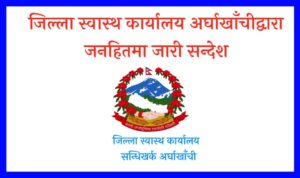29 Sep, 2021
By Sampada A. Khatiwada The Rising Nepal
Kathmandu, Sept. 29: Cases of Seasonal Hyperacute Panuveitis, commonly known as SHAPU, are increasing in Nepal in recent times. Physical contact with Moths (Seto Putali) is considered to be the major cause of SHAPU.
Stating that delay in treatment of the disease could cause blindness, the Ministry of Health and Population (MoHP) has repeatedly been calling people to stay alert and opt for measures to avoid contact with white moths. Similarly, ophthalmologists have also warned that the spread of SHAPU could invite some serious health concerns if left untreated.
According to the Health Ministry, cases of SHAPU are mostly seen in mid-hill regions including Pokhara, Syangja, and Parbat districts. Some cases were also seen in Kathmandu.
Dr. Krishna Prasad Poudel, spokesperson for the MoHP, said, “The Himalaya Eye Hospital in Pokhara has reported around 35 cases of SHAPU until now.”
What is SHAPU?
SHAPU was reported for the first time in 1975 AD in some children in Pokhara.
According to Dr. Poudel, SHAPU is a disease that can damage our eyes within hours, one of its own kind. “As the disease is primarily caused by moths, SHAPU is mostly reported during their breeding season from mid-August to mid-December.”
Dr. Sanjiv Bhattarai, ophthalmologist at TU Teaching Hospital, said, “This disease can cause blindness in no time. When the hair of white moth enters the eye, it immediately affects three layers of the eyes including the pupil, inner lens cells and vitreous body.”
“As the hairs of white moths consist of nitric oxide and potassium cyanide, their reaction affects the human eye,” said Dr. Poudel, adding, “People of all age groups could be vulnerable to this disease.”
Both Dr. Bhattarai and Poudel said that SHAPU was a serious disease as it could cause blindness within 24 to 48 hours of infection.
Symptoms
Dr. Kamal Bahadur Khadka, chief of Nepal Eye Hospital, said that sudden redness of any one eye, dryness, impaired vision were the major symptoms of SHAPU.
“In some cases, white pupillary reflex (leukocoria), mild pain in the eye, inability to see in the light, and rapid and severe loss of vision is also reported,” said Dr. Khadka.
Treatment
Dr. Bhattarai said that one must visit an ophthalmologist as soon as the symptoms are seen. “Blindness can result within two days of suffering from SHAPU. Thus, timely treatment is the only way to cure the disease.”
He added that medicine and injections are given directly to the infected eye. “Some serious cases with severe infection might also require surgery,” said Dr. Bhattarai, adding that visiting an eye hospital is a must to cure the disease.
Prevention
MoHP Spokesperson Dr. Poudel said, “There are grave consequences of SHAPU. Thus, we must try our best to keep the disease at bay.
For the prevention of SHAPU, physical contact with moths should be avoided. “As moths are mostly found around tube
lights and other light bulbs, we should not eat, sleep, play or study around white light bulbs,” said Dr. Poudel.
“Averting use of white lights at home, shutting windows and doors to prevent moths from entering our rooms and using nets in windows and doors could also help in preventing physical contact with moths,” he added.
Dr. Poudel said, “If moths come in contact with our hands or any other body part, then we should wash our hands or the body part immediately with soap and water.”





